Canals were a real problem for the early railway builders, as is illustrated by the steep gradients on the approaches to Euston and King’s Cross, where the railway was built respectively over and under the Regent’s Canal. The Midland Railway avoided this problem by building an elevated station at St Pancras.
In Scotland, the Monklands canal forced the Edinburgh to Glasgow railway to build a tunnel with a 1 in 41 gradient to reach its Glasgow Queen Street terminus whilst various bridges and tunnels were needed to cross the Forth and Clyde canal which cut across central Scotland.
It could have been worse if Robert Stephenson, of lighthouse fame, had had his way. In 1817, Stephenson proposed a level canal between Glasgow and Edinburgh. This was to have a basin where Edinburgh Waverley station is now, following the line of what was to be the railway through Princess Street gardens to Haymarket and then continuing along the 155-foot contour to join the Forth and Clyde canal at its summit pound, seven miles west of Falkirk, which extends to Port Dundas in Glasgow.
A canal without any locks between Scotland’s two main cities was a commercially attractive proposition for both passengers and freight. However, there was a snag – it required the construction of a three-mile-long two-way canal tunnel at Winchburgh. The costs and risks of such a tunnel were too much for the canal’s promoters, who chose Hugh Baird’s line to build the Edinburgh and Glasgow Union Canal, which opened in 1822. A swift passenger boat was then introduced that took eight hours between the two cities and carried 200,000 passengers a year.
The Union Canal is a level canal that follows the 240-foot contour from Fountainbridge in Edinburgh to Falkirk. There, it joined the Forth and Clyde canal by a flight of 11 locks, which were demolished in the 1930s. The Millennium Link restored these two canals and, in 2002, re-joined them by the Falkirk Wheel, which is Scotland’s 15th most visited tourist attraction.

When the Edinburgh and Glasgow Railway opened in 1842, it took away all of the canal’s passenger traffic and much of its freight traffic. Eventually, in 1849, the railway took over the whole Union Canal. Evidence of this common ownership can by seen at the Linlithgow Union Canal Society’s basin, where the railway’s original stone block sleepers line the quayside.
As railways were built, the canal companies were gradually put out of business and, for many years, there has been little interaction between canals and the railway. However, in August 2020, there was a significant exception.
12 August
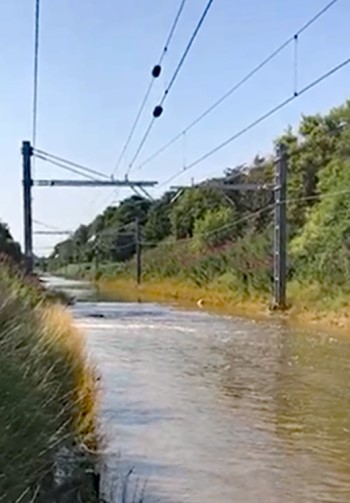
In the early morning of 12 August, eastern Scotland experienced exceptionally severe storms that tragically resulted in the fatal train crash at Carmont, where 52mm of rain had fallen between 05:00 and 09:00. Further south, near Polmont, 80mm of rain fell between midnight and 06:00, with 44mm falling in one hour around 05:00. The Scottish Environmental Protection Agency subsequently considered this to be a 1-in-240-year event, although, during the night of the storm there was only a Yellow warning in place.
At 05:46, multiple track circuit failures on the Edinburgh to Glasgow main line between Polmont and Bo’ness junction were reported to Network Rail Scotland control. The driver of 2J53, the 05:03 from Edinburgh to Glasgow, reported that water was above the rail head on both lines at this location and was flowing fast. 2J53 was the first, and the last, train over the line that day.
Scottish Canals received a report that the Union Canal had been breached at Muiravonside, between Linlithgow and Polmont, at 08:00. The breach was initially a few metres across, eventually growing to a 30-metre gap in the six-metre-high canal embankment, through which a vast amount of water was flowing.
At 08:52, the Cathcart Electrical Control reported an overhead line trip in the area as overhead line structures collapsed after their foundations were washed away.
By 11:00, Scottish Canals had put stop planks under bridges at Brightons, near Polmont, and Linlithgow. This restricted the loss of water to six kilometres of the 51-kilometre level canal. By this time, the level of the canal at Linlithgow, 4.6 kilometres from the breach, had dropped by half a metre.
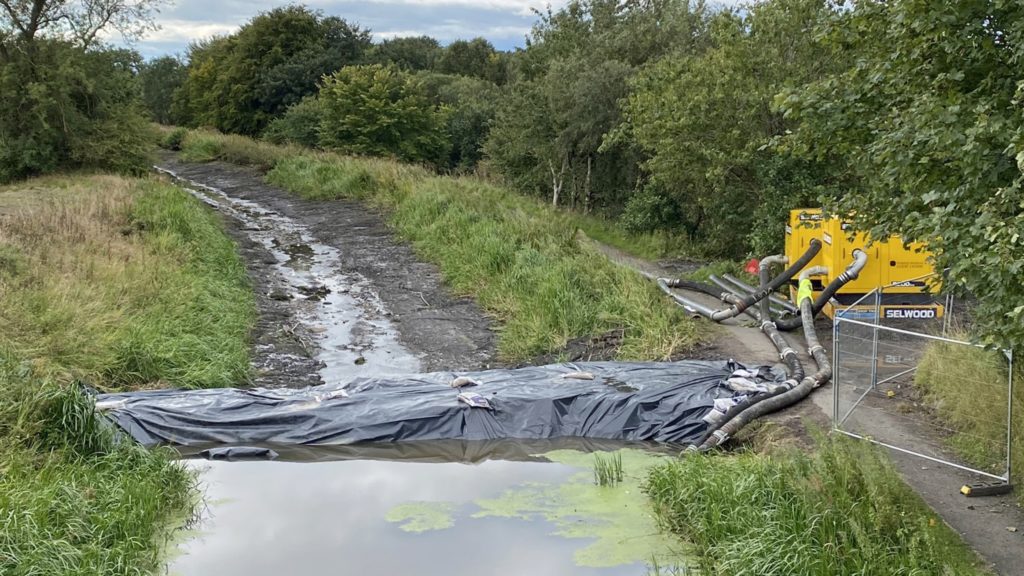
Later that afternoon, Scottish Canals contractors Mackenzie Construction installed emergency sandbag dams under bridges either side of the canal to contain the leaking section to one kilometre, which significantly reduced the water flow through the breach. By this time, tens of thousands of cubic metres of water had poured onto the adjacent railway line.
The next day, clay dams were installed 100 metres either side of the breach to completely stop the water flow through it. As the canal is fed only from its eastern end, a pumping system was provided at the east end of the breach to pump water to the west side of the breach through pipes that bypassed the drained section of the canal. A week-long fish rescue exercise was then undertaken to move over eleven thousand trapped fish, including a one-metre-long 30-year old eel, to unaffected sections of the canal.
Canal Asset Management
Scottish Canals manage the Caledonian, Crinan, Forth & Clyde, Monkland and Union canals, which total 140 miles of waterway. Its 2018/19 accounts show that £9.1 million (£65,000 per mile) was spent on major infrastructure and core waterway works, and note that its historic assets have been in a steady state of decline, with the risk of asset failure ever present. Unlike Scotland’s canals, it would be wrong to describe railway earthworks as being in decline as Network Rail’s investment in them has doubled in the past ten years to £1.3 billion in Control Period 6 (2019-2024). However, canal and railway assets are both at risk from severe weather events.
To address this risk, the Scottish Canals’ asset management strategy shows how work on their 4,100 assets is prioritised through a risk assessment process. This had identified that 175 assets presented a ‘high’ or ‘severe’ risk of failure.
Scottish Canals director of infrastructure Richard Millar told Rail Engineer that these high/severe risk assets did not include the failed embankment at Muiravonside. He noted that this 200-metre long embankment was a “substantial, chunky” earthwork with much clay in its cross section. It had received a principle examination by a qualified engineer in 2018. Such examinations are undertaken every three to ten years according to risk. Each part of the canal also receives a monthly inspection and an annual detailed inspection.
The 51-kilometre Union canal has 13 ‘waste’ weirs along its length to regulate the level of water in it. Richard advised that, during the storm, significant flows were generated in the upstream catchment resulting in large uncontrolled flows into the canal which had overwhelmed these weirs resulting in the canal overtopping at several locations. At Muiravonside, this eroded the embankment to create a 30-metre wide breach. He considers the repair of this breach repair is a big job that will take some months.
Following the Muiravonside breach, Scottish Canals are considering how canals can be made more resilient to such severe weather events. Richard advised that Scottish Canals are working closely with Network Rail in respect of the railway flood repair work and envisages that the two infrastructure companies will share their strategies to improve the resilience of their 19th century infrastructure.
He also pointed out that canals can also be part of the solution for severe weather events as they can accommodate and move large volumes of water. As an example, he mentions the ‘Glasgow Smart Canal’ scheme that has paved the way for 3,000 new homes in Glasgow by contributing to a wider scheme to mitigate flood risk. This will be done by actively and autonomously lowering the water level in the Forth & Clyde canal by up to 10cm to accommodate 55,000 cubic metres of floodwater when severe weather is predicted.
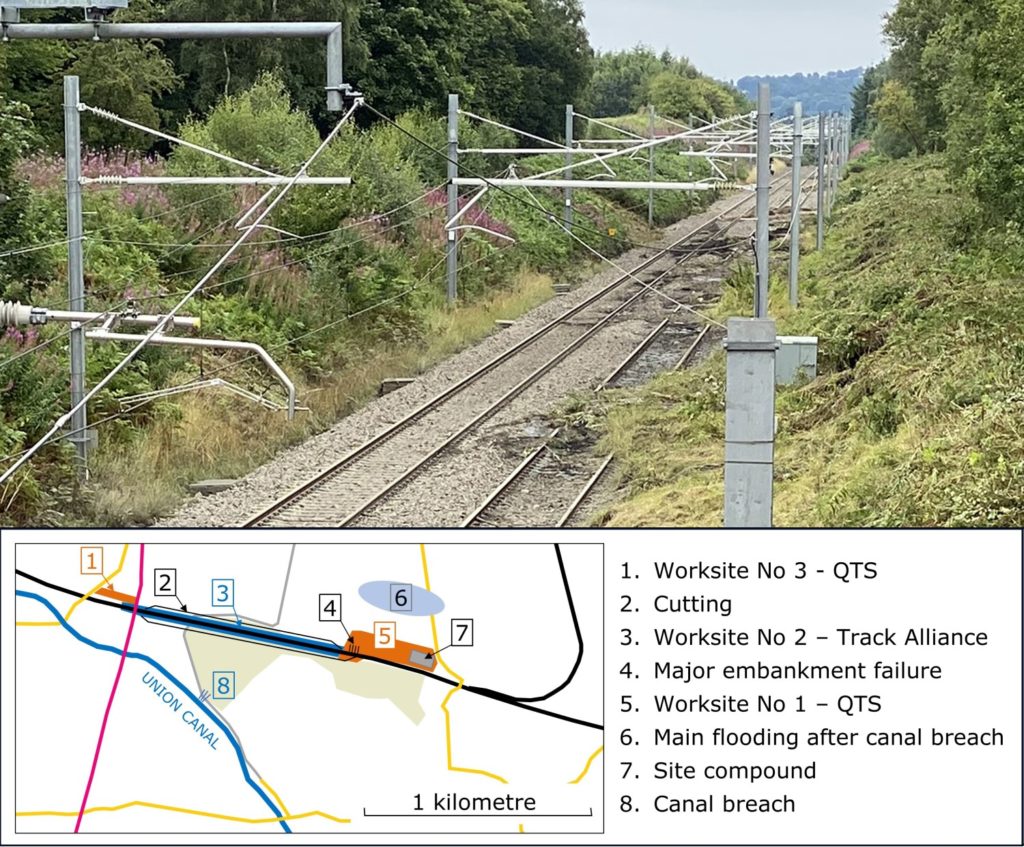
Après le déluge
As the fast-flowing water escaped from the canal, it flowed down through a wood for 300 metres before pouring over the south side of a one-kilometre long shallow cutting on the Edinburgh to Glasgow main line. Little damage was done at this point as the wood had spread the flow.
At this point the line is on a very slight, 1 in 882 gradient that falls eastwards towards Edinburgh. The flood water covered the rails in the cutting and poured out of both ends of it with most flowing out of the east end of the cutting. It was here that most of the damage was done as the water poured down a 10-metre high embankment on the north side of the line to flood the fields below. The scour of tens of thousands of tonnes of water changing and speeding up dug out OLE mast foundations and about 150 metres of trackbed, leaving sagging, unsupported track in a scene reminiscent of Dawlish in 2014.
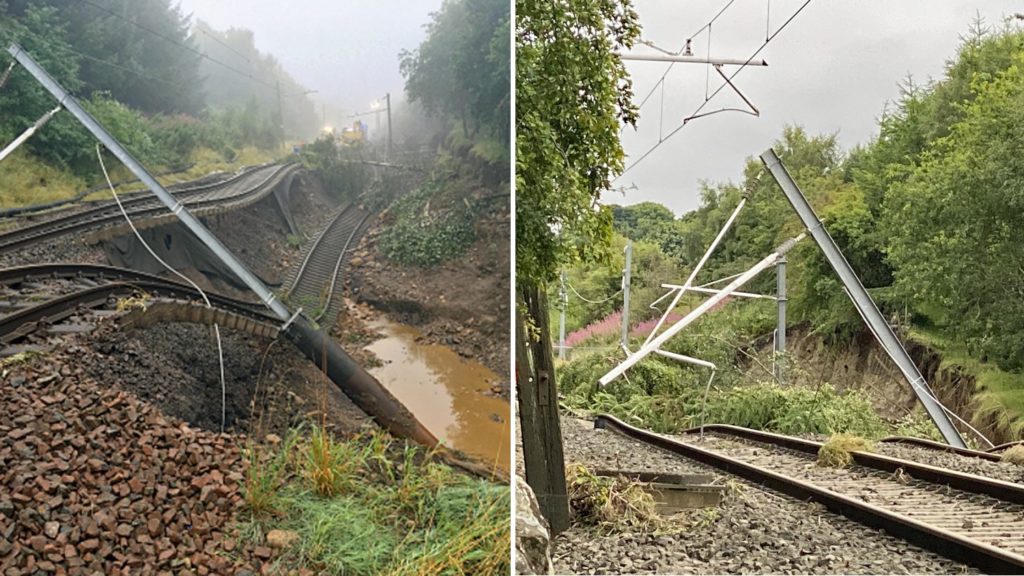
Network Rail’s project manager for the flood repair works, Mark Wilson, advised that it took three days for the water to filter through the site before a full damage assessment could be made. This found that there was:
- One kilometre of contaminated ballast;
- Three kilometres of track formation to renew;
- Two embankment failures, one of which was up to nine metres deep, and significant soil cutting failures;
- Five kilometres of signalling cable requiring renewal and location cases damaged from water ingress;
- Two collapsed OLE masts with associated wiring damage;
- 8,000 to 10,000 tonnes of track formation debris from the main failure site that had been deposited on non-arable third-party land. A decision on whether this has to be moved has yet to be taken.
Design
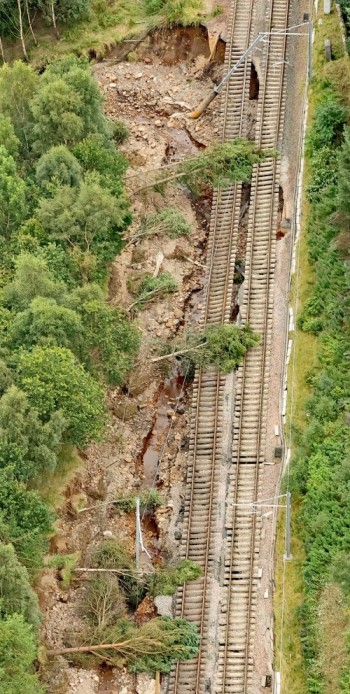
Network Rail’s geotechnical framework contractor QTS, supported by COWI, which provides geotechnical engineering services, was immediately mobilised to establish a site compound below the main embankment failure. For Mark, the urgent timeframe to prepare the design was particularly challenging. He advised that the geotechnical design was derived from designer’s sketches from which retrospective Form 001 and 002s were produced, as allowed by the civil engineering assurance standard. Geotechnical designers were also on site throughout to supervise the works.
The design for the new formation at the main embankment failure area required an infill of between 1.5 and nine metres, which consisted of a compacted primary fill layer of 6B (100-300mm) stone followed by incremental layers (130mm to 150mm thick) of compacted 6F5 stone to reach final formation level. In all, approximately 9,500 tonnes of stone would be needed.
The Rail Systems Alliance Scotland, a three-way joint venture of Network Rail, Babcock Rail and Arcadis, designed the track renewal, signal and telecoms remediation works as well as the soil cutting damage repair within the track renewals worksite. It was agreed with the route asset manager that a category 11 track renewal (rerail, resleeper and reballast) was required. A combined form A/B for track design was produced, reviewed and accepted to allow approved for construction drawings to be issued six hours before work started.
The scope of the signalling and telecoms work was informed by advice from the local maintenance team. The S&T cables were located in two separate troughing routes, one in the cess and one at the crest of the soil cutting. To improve maintainability and increase resilience it was decided to rationalise this by cutting and re-locating the cables into one cable trough within the cess with new location cabinets installed at appropriate locations.
This required several signalling cables to be cut and 3,000 metres of new cables to be run in. One saving was that it was found that the fibre optic telecoms cable, installed during the Edinburgh to Glasgow improvement programme (EGIP), could be reused.
The remedial overhead line equipment work was designed by SPL Powerlines and was aided by the use of EGIP records for the design of foundations for the two new twin track cantilever overhead line structures on the south side of the track. These replaced single track OLE masts at the two locations where masts on the north side of the track had had their foundations washed away.
It was considered that twin track OLE gantries were a more robust and ‘future proof’ solution in accordance with what Mark described as “Scotland’s railway ethos of building back better”. This decision also aided the programme, as it meant that the mast’s foundations were away from the embankment remedial work.
Delivery
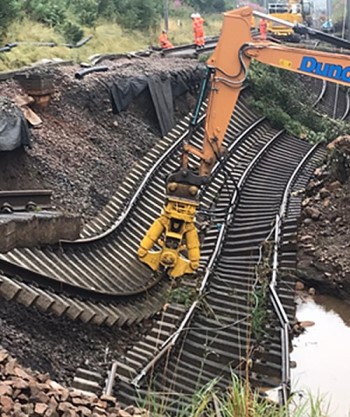
Mark considers that the most significant challenges in delivering these remedial works were compliance with the Construction, Design and Management Regulations (with three different contractors on site), finalising remits from the various asset managers with very short timescales, liaison with the many parties involved and engineering train planning. Furthermore, having initially estimated six and a half weeks to complete the work, his team were challenged to achieve five and a half weeks. He advised that the project planning needed to achieve this was quite demanding.
The CDM issues were resolved by having three distinct sites of work. QTS was the principal contractor for the embankment remediation sites at each end of the cutting. Between these two sites, the Rail Systems Alliance Scotland was the principal contractor for the track renewals site. Other contractors on site included Story Contracting, which provided rail plant, and SPL Powerlines for the installation of the twin track cantilever masts and OLE repairs.
Although Scottish Canals contractors have their own compounds and separate access arrangements, there was a requirement for some common site access, for example visits of the loss adjusters. There are also ongoing discussions with Scottish Canals regarding the mitigation of any repeat occurrence, especially as the canal lies above and close to the railway for several kilometres.
Achieving the formation level in time for track renewal works was very much on the critical path and did happen just in time. Once the embankment works were complete, the three worksites were merged into one track renewals site.
The 27 engineering trains for the track renewals work were also on the critical path and required the replanning of train moves and engineering work across the network. One such train was that with Rhomberg Sersa’s MFS+ (material conveyor and hopper unit with transfer conveyor belt and caterpillar track) which was sent to Polmont from its deployment on Scotland’s Far North line. As reported in issue 180 (December 2019), the MFS+ is a high-output conveyor/hopper wagon that can lift itself clear of the running line and then wander off into an excavation. At Polmont, it was used to deposit ballast away from the railhead.
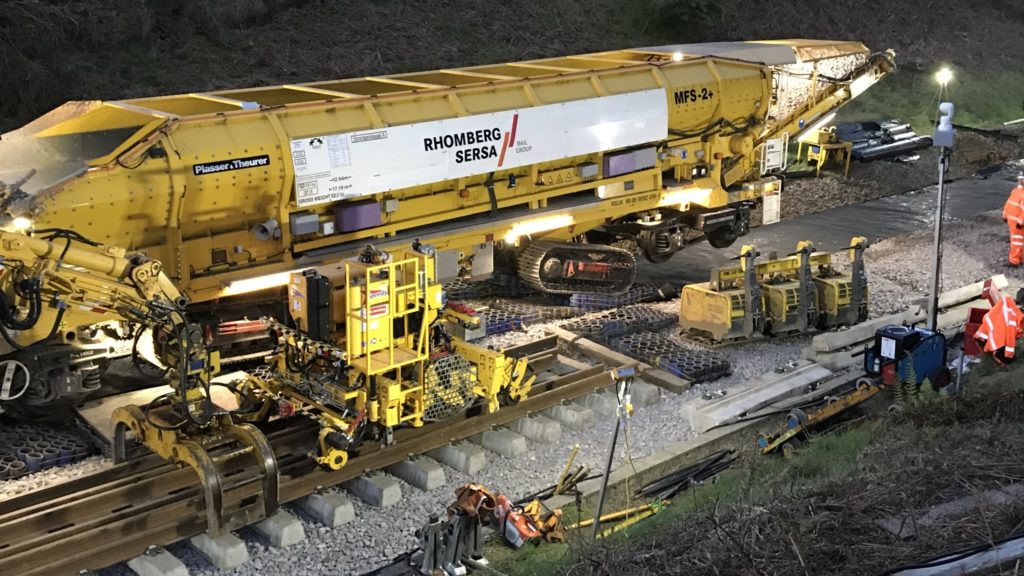
At the track renewal site, the contaminated ballast was excavated out and existing formation level was cleaned. 10,000 tonnes of new ballast was laid on a geotextile layer on top of the cleaned new formation.
The existing rails were not re-used as they had to be cut into panels to enable efficient removal from site. New rails were run in by engineering trains and laid in the four-foot of the opposite line. The Down line renewal was completed first, followed by the Up line. Work then transferred to the embankment failure site where both lines were renewed once formation level was achieved. The track renewal required 4,500 metres of new rails and 4,424 concrete sleepers.
During the flood repair works, there were no passenger trains between Falkirk and Linlithgow. Whilst the line was closed, other work was carried out to take advantage of this possession, including signalling upgrade works at Falkirk High tunnel, devegetation through the Polmont area and other minor earthwork repairs elsewhere following the storm on 12 August.
After all work had been completed, all the relevant handback paperwork was gathered to show that the new and repaired assets are “suitable, sufficient and correctly configured to provide for the safe functional operational requirements of the railway infrastructure” as required by Network Rail’s ‘Entry into operational service’ standard.
Once this was done, services on the main Edinburgh to Glasgow route resumed on 21 September with a temporary 60mph speed restriction, 40 days after the line’s inundation by the Union Canal. Commenting on the work, Michael Matheson, the Scottish Government’s Cabinet Secretary for Transport, Infrastructure and Connectivity, stated “The scale of the challenge faced by those repairing the damage to this vital route was huge and that they have delivered this so promptly is testament to the hard work and dedication of staff across Scotland’s Railway.”
It’s hard to disagree with him.

